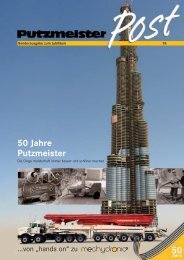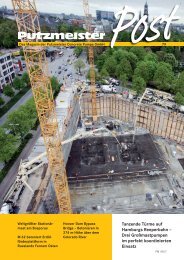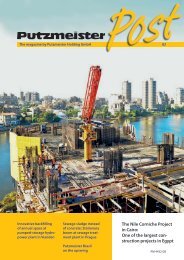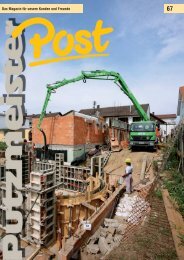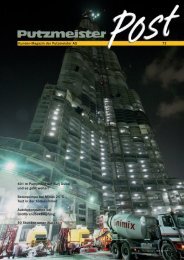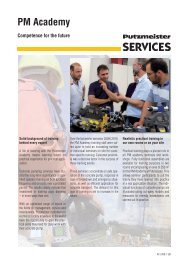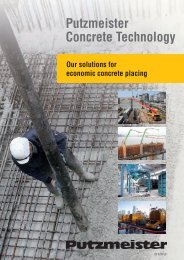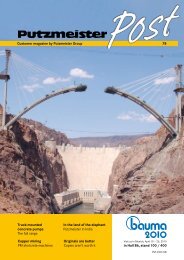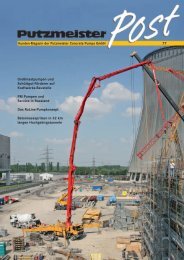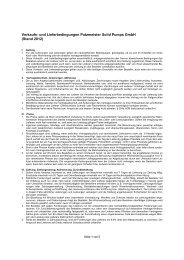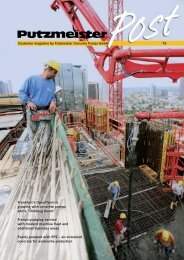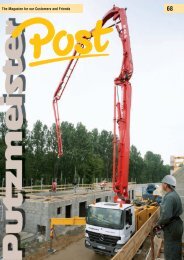The 4h pumping of Neufahrn: Large boom team places ... - Putzmeister
The 4h pumping of Neufahrn: Large boom team places ... - Putzmeister
The 4h pumping of Neufahrn: Large boom team places ... - Putzmeister
You also want an ePaper? Increase the reach of your titles
YUMPU automatically turns print PDFs into web optimized ePapers that Google loves.
Title story Title story<br />
In 24 hours, a total <strong>of</strong> approx. 2,000 m 3 <strong>of</strong><br />
concrete C40/50 was placed with a compressive<br />
strength <strong>of</strong> 42.5 N/mm 2 (exposition<br />
classes XC4, XD1, XF2). This is the quantity<br />
<strong>of</strong> concrete for the entire cross-section <strong>of</strong> the<br />
structure <strong>of</strong> section 1 including footbridges<br />
and carriageway slabs (see the box containing<br />
data about the concreting). <strong>The</strong> complete<br />
superstructure (sections 1 and 2) will<br />
contain 3,400 m 3 <strong>of</strong> concrete.<br />
So that traffi c can ultimately travel on the<br />
road comfortably and safely, the fi nished<br />
concrete surface receives another 8 cm thick<br />
layer to the overall construction. <strong>The</strong> concrete<br />
is fi rst primed and completely sealed<br />
using epoxy resin. An asphalt sheeting (0.5<br />
cm) comes next and then a protective layer<br />
<strong>of</strong> mastic asphalt (3.5 cm thick). Finally, the<br />
surface <strong>of</strong> the road is formed by a 4.0 cm<br />
surface layer <strong>of</strong> stone mastic asphalt. n<br />
Technical data <strong>of</strong> the concrete pumps on site<br />
M 58-5 M 6 -6<br />
Folding type 5-Arm roll-Z-fold 6-Arm roll-Z-fold<br />
Vertical reach 57.6 m 61.1 m<br />
Horizontal reach 53.6 m gross 57.1 m gross<br />
49.4 m net 52.4 m net<br />
Reach depth 42.4 m 44.3 m<br />
Unfolding height 12.3 m 23 m<br />
Delivery line DN 125, max. 85 bar Arm 1, 2 DN 125, max. 85 bar<br />
Arm 3, 4, 5, 6 DN 117, max. 85 bar<br />
Support width front / rear front / rear<br />
normal approx. 11.1 m / approx. 11.5 m approx. 12.1 m / approx. 12.3 m<br />
OSS approx. 8.7 m / approx. 8.0 m approx. 8.8 m / approx. 8.3 m<br />
Properties <strong>of</strong> fresh concrete<br />
Strength class C40/50<br />
q In the middle <strong>of</strong> the motorway but nevertheless secure: <strong>The</strong> concreting is carried<br />
out quietly while the traffi c can fl ow freely under the bridge construction.<br />
This photo shows the M 58-5 on the north-eastern ramp.<br />
12 13<br />
Exposition classes XC4 Changing wet and dry (e.g. exterior components with direct<br />
exposure to rainfall, components in water tidal zones)<br />
XD1 Moderate moisture (e.g. components in areas where water<br />
may spray from traffi c areas)<br />
XF2 Moderate water saturation with de-icing agents (e.g. concrete<br />
components in areas where water may spray from traffi c<br />
areas that have been treated with de-icing agents)<br />
t To determine the water content, the<br />
concrete is heated up until it no longer<br />
contains any liquid.<strong>The</strong> difference in<br />
weight can be used to determine the<br />
water content.<br />
8 PM 4356 GB PM 4356 GB 9<br />
Steel used<br />
Untensioned reinforced steel 280 t Prestressing steel 107 t<br />
Thickness <strong>of</strong> the layer <strong>of</strong> placed concrete<br />
in the area <strong>of</strong> the webs 2.40 m in the centre <strong>of</strong> the carriageway 0.35 cm<br />
q After a quick clean, the truck mixers<br />
rejoin the queue <strong>of</strong> motorway traffi c in<br />
order to fetch more concrete<br />
14<br />
‚ Exposition classes<br />
and what they mean<br />
To ensure that the durability is suffi cient,<br />
concrete components must be strong<br />
enough to withstand chemical and physical<br />
impact on their environment and<br />
their use. <strong>The</strong> impacts from the various<br />
environmental conditions are classifi ed<br />
into exposition classes that may have an<br />
impact on the concrete, the reinforcing<br />
steel and metallic components and that<br />
are not accounted for as loads during<br />
the constructive assessment. From this,<br />
the requirements are derived for the<br />
composition <strong>of</strong> the concrete to be used,<br />
as well as the concrete cover and the<br />
permitted crack width.<br />
<strong>The</strong> designations for the individual exposition<br />
classes are made up <strong>of</strong> the letter<br />
X (for exposition), the identifi cation<br />
for the type <strong>of</strong> damaging effect and a<br />
number that denotes the intensity <strong>of</strong> the<br />
damaging effects. <strong>The</strong> following abbreviations<br />
are used from English for the<br />
various types <strong>of</strong> effects:<br />
0 for zero risk (no risk <strong>of</strong> attack)<br />
C for carbonation<br />
D for de-icing salt (chlorides that are<br />
capable <strong>of</strong> changing, e.g. from deicing<br />
salt)<br />
S for seawater<br />
F for frost (frost and de-icing salt)<br />
A for chemical attack<br />
M for mechanical abrasion, wear, or<br />
similar<br />
<strong>The</strong> strength <strong>of</strong> the relevant ambient<br />
condition is assigned a classifi cation<br />
from 1 to 4.<br />
In Germany, the exposition classes are<br />
regulated by DIN 1045-1 (08-2008).<br />
In contrast to the previous version from<br />
2001, the effect W „concrete corrosion<br />
due to alkali silicic acid“ has been added<br />
to the exposition classes. No minimum<br />
concrete strength class is assigned to<br />
this exposition.<br />
[Source: wikipedia.de, licensed under<br />
http://creativecommons.org/licenses/by-sa/3.0/deed.de.]



